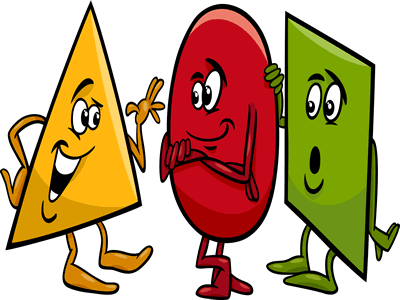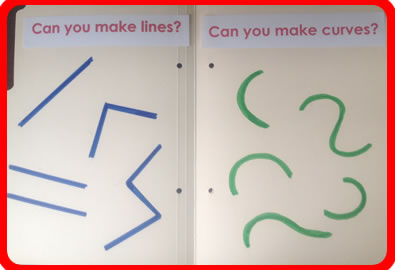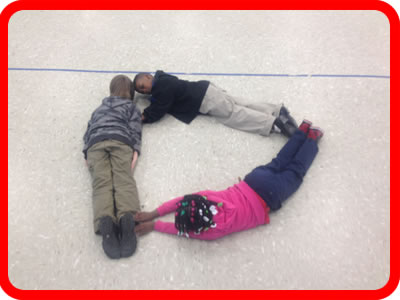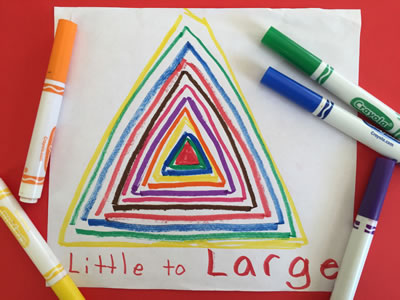March 2015
GEOMETRY
Identify and describe shapes
Horizontal, Vertical (Tune: “Where Is Thumbkin?”)
(Carrie O’Bara and Terri Miller)
Horizontal, horizontal,
(Forearms held up horizontally in front of chest.)
Vertical, vertical.
(Forearms bent at elbows to form right angles.)
Horizontal, horizontal,
Vertical, vertical.
Then diagonal, then diagonal.
(Right arm slants in front and then left.)
Add a curve. Add a curve.
(Make a “c” with right hand and then left.)
Then diagonal, then diagonal.
Add a curve. Add a curve.
Shapes (Tune: “Alice the Camel”)
Triangles have three sides. (Hold up 3 fingers.)
Triangles have three sides. (Draw an invisible triangle in the air.)
Triangles have three sides.
Three straight sides.
Triangles have 3 corners…
Note! After singing about 3 corners, explain that you can also call those vertices.
Triangles have 3 vertices…
Squares have four sides - four equal sides… (Hold up 4 fingers.)
Squares have four vertices…
Rectangles have four sides - 2 short and 2 long sides…
Hexagons have six sides – six equal sides…
(Hold up 3 fingers on each hand.)
Circles have no sides…the circle curves around.
(Shrug shoulders and shake head.)
Spy a Shape (“Totally Math” CD) (Tune: “Do You Know the Muffin Man?”)
Do you spy a circle, circle, circle? (Make circles with thumb and index finger
Do you spy a circle in the room? and put around eyes as you sing.)
Yes, I spy a circle, circle, circle. (Children point to a circle.)
Yes, I spy a circle in the room.
Can you draw a circle, circle, circle? (Draw an invisible circle in the air.)
Can you draw a circle nice and round?
I can draw a circle, circle, circle.
I can draw a circle nice and round.
Square… 4 equal sides.
Triangle…3 sides that slant.
Rectangle…2 long and 2 short sides.
• Have children draw shapes in the air with elbows, feet, noses, and other body parts.
• Let children get up and touch different shapes in the room as you sing the song.
Touch Something
Children walk around the room and touch shapes as you call them out.
Spyglass
Let children decorate toilet paper rolls with markers and crayons. These are their spyglasses for finding shapes. Can you spy a circle? Can you spy a rectangle?
• Use the spyglasses on a nature walk or around the school to identify shapes.
3-D Snack
Take four lunch bags and write “spheres,” “cubes,” “cones,” and “cylinders” on the bags. Fill the bags with appropriate items, such as cheese balls/spheres, caramels/cubes, Bugles/cones, and marshmallows/cylinders. Take one bag at a time and say, “I have a sphere for each of you to eat. What do you think it could be?” Children brainstorm foods that are spheres. Pass out a sphere to each child. Encourage children to name the solid and describe the shape before eating the item.
Analyze, compare, create, and compose shapes
Pretzel Shapes - Give children pretzel sticks and pretzel twists and challenge them to make geometric shapes. How many pretzel sticks will you need to make a hexagon? How many pretzel sticks will you need to make a triangle?
How can you make a circle out of the pretzel twist?
Heart Puzzle - You will need a 4” square and a 4 “ circle. Cut the circle in half. Challenge the children to make a heart out of the square and two semi-circles.

Play Dough Book - Draw geometric shapes with a marker on file folders. Laminate. Bind file folders with rings to make a book. Children roll play dough and place it on top of the shapes.

Body Shapes
Divide children into groups of 4 or 5. Challenge them to lay on the floor and make shapes with their bodies. How many friends will you need to make a triangle? A hexagon? Take photos and use these to make a class book of shapes.
Shape Art
Cut geometric shapes out of construction paper and let children use them to make a collage. Can they arrange them to look like an object or animal?
• Cut sponges into geometric shapes and have children dip them in paint and stamp on paper.
2-D and 3-D Art
Brainstorm artwork that is two-dimensional. What artwork is three-dimensional? Let children draw or paint pictures that are flat. Give them recycled materials (such as paper towel rolls, tissue boxes, plastic water bottles) to create three-dimensional art.
Shape Book
Fold two sheets of paper in half and staple. Children decorate the front of their book with shapes. Next, they walk around the room and draw shapes that they see. Can they label the shapes?
• This would be a good homework activity to help children be more aware of the shapes around their home.
Graham Crackers
Give each child a large graham cracker. What shape is it? Break it in half. What shape is it now? Break the squares in half. What shape do you have now?
*Let children nibble saltines to make circles and triangles.
Toothpick Sculptures
Give children toothpicks and play dough. What flat and solid shapes can they create?

Little to Large
Make a very small shape (triangle, square, trapezoid, half-circle, etc.) in the
center of a sheet of paper. Children take different colors of crayons and to
around the shape, making it a little larger each time until it completely fills
the page.
MATH IS FUN!
CHORUS
Math, math is so much fun,
So much fun for everyone!
Math! Yea, math!
Numbers, symbols (measures), shapes and signs
We use math all the time!
Yea, math!
Numbers, numbers, I see numbers everywhere I look—
Price tags, speed limits, calendars, and books.
How much money have you saved, how many kids at school?
Now add them all together…
And you’ll get numbers, numbers—math is so cool! CHORUS
Shapes, shapes I see shapes everywhere I look.
A rectangle’s a window or a door or a book.
Do you see a triangle, a circle, or a square?
An oval or a pentagon?
So many shapes, shapes—math is everywhere! CHORUS
How long does a school day last, how many in a pair?
How many miles you traveled to get from here to there;
What day is your birthday on, how old are all your friends;
Now add them all together…
And you’ll get math, math! It never ends! CHORUS
Websites
Check out these websites for more awesome math ideas!
www.illuminations.nctm.org
www.k-5mathteachingresources.com
www.fuelthebrain.com
www.mathwire.com
www.ixl.com/standards/common-core/math/kindergarten
www.illustrativemathematics.org
www.mathplayground.com
www.coolmath4kids.com
• Most states also offer practical suggestions, materials, and activities for enriching math standards.